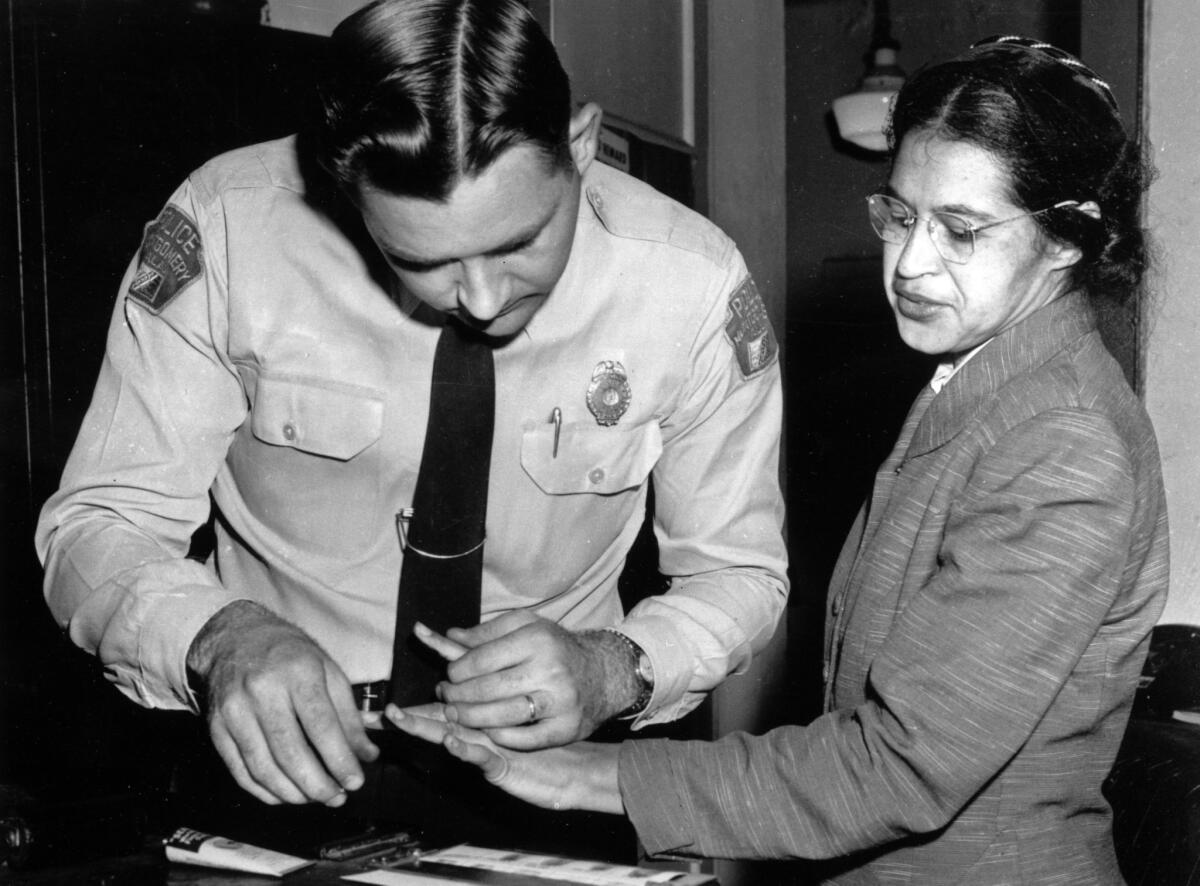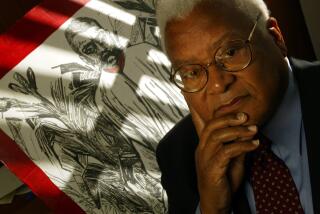From the Archives: Rosa Parks, dies at 92; civil rights icon set wheels of justice in motion

- Share via
Rosa Parks, the Alabama seamstress whose simple act of defiance on a segregated Montgomery bus in 1955 stirred the nonviolent protests of the modern civil rights movement and catapulted an unknown minister named Martin Luther King Jr. to international prominence, died Monday of natural causes at her home in Detroit. She was 92.
Often called the mother of the movement that led to the dismantling of institutionalized segregation in the South, Parks became a symbol of human dignity when she was jailed for refusing to relinquish her bus seat to a white man when she rode home from work on the evening of Dec. 1, 1955.
Her arrest for violating Alabama’s bus segregation laws galvanized Montgomery’s blacks, who boycotted the city’s buses for 381 days until the U.S. Supreme Court declared the law unconstitutional.
“Her legacy was her quiet dignity and instinctive rage against injustice,” Rep. Diane Watson (D-Los Angeles) told the Times on Monday night. “What she determined on the spot was that her dignity would not allow her to be treated unjustly.”
A candlelight vigil in Parks’ honor will be held at 6:30 tonight at Leimert Park, 4395 Leimert Blvd., Los Angeles.
Memorialized in poetry, dance and song, Parks was, by most accounts, both simpler and more complex than the mythology that grew around her.
She was born Feb. 4, 1913, in Tuskegee, Ala., to Leona Edwards, a teacher, and James McCauley, a carpenter and builder. Her parents split up when she was 5, prompting her mother to move Rosa and her younger brother Sylvester to live with family in Pine Level, a small town near Montgomery.
Some of her early memories were of white people who treated blacks kindly, particularly a Yankee soldier who said she was cute and “treated me like I was just another little girl, not a little black girl,” Parks wrote in her 1992 autobiography, “Rosa Parks: My Story.”
But she also remembered an old black man named Gus Vaughn who refused to work for whites. And she remembered how her grandfather kept a gun by his side to protect the family from raids by the Ku Klux Klan during the 1920s.
The earliest hint of the fortitude that would bolt her to a bus seat years later may have come when she was 10. On the road near home, she had encountered a white boy named Franklin, who uttered some offensive words and threatened to hit her. Young Rosa picked up a brick and dared him to strike. Franklin, she recalled, “thought better of the idea and went away.”
Her grandmother was horrified by Rosa’s behavior. You’ll be lynched before you turn 20 if you keep standing up to whites, she scolded.
Parks once speculated that the urge to stand up to oppressors may have come from protecting her little brother from bullies. Whatever the cause, “I do know,” she wrote, “that I had a very strong sense of what was fair.”
Her mother was her only teacher until she was 11, when she was sent to the Montgomery Industrial School. Founded and staffed by whites to educate black children, the school was burned down twice by arsonists and the faculty was ostracized by the white community.
Parks took academic classes there, as well as some vocational training. But she said the most important lesson she learned “was that I was a person with dignity and self-respect, and I should not set my sights lower than anybody else just because I was black.”
She went to high school at a laboratory school run by the Alabama State Teachers College for Negroes, but was forced to drop out to care for her grandmother and later for her mother. She went back to school for her degree in 1933, after she married Raymond Parks, a Montgomery barber. Raymond Parks was also an activist in the local NAACP and helped raise money to defend the nine black men accused in the Scottsboro rape case, one of the most sensational racial trials of the Depression era. He was the first man aside from her grandfather with whom Parks could discuss racial conditions, and it impressed her that he was not afraid of whites.
After her marriage, Parks held a succession of jobs, from domestic worker to hospital aide. To get to work, she rode the bus, as the majority of blacks did. But black bus passengers had to follow certain rules. The first 10 seats were reserved for whites, even if no whites got on the bus. Blacks had to sit in the back rows or, if those were filled, stand. If the white section filled up, some drivers ordered blacks to give up their seats.
Bus drivers determined the rules. Some drivers made black passengers board through the front door to pay their fare, then reenter through the back door to find a seat. If they were unlucky, the bus would take off before they had a chance to get back on.
One day in 1943, Parks boarded a bus to register to vote. But the back of the bus was standing room only. Instead of stepping off to go to the back door after paying her fare in front, Parks walked down the aisle.
The driver, James Blake, demanded that she disembark and re-board at the rear of the bus. Parks got off and waited for the next bus. She swore to herself never to ride with that driver again.
But on a winter evening 12 years later, after a long day at work, Parks got on a bus to go home, forgetting to check who was behind the wheel.
She was by then an active member of the National Assn. for the Advancement of Colored People and a recent graduate of Highlander Folk School in Tennessee, a training ground for civil rights workers where whites served her meals and studied side by side with her as her equal.
When she got off work on that December evening, she was preoccupied with final arrangements for an upcoming NAACP workshop. She paid her fare before she noticed that the driver was Blake.
She saw an empty seat in the middle of the bus — “no man’s land” — and took it. At the next stop, the white section filled up and one white passenger was left standing. Blake told Parks and the three other blacks in the front rows of the black section, “Let me have those front seats.”
They all balked, at first. Then, after Blake ordered them up again, three complied. Parks refused to budge.
The only words she spoke were “no” when he asked her if she was going to stand up, and “You may do that” when he said he would have her arrested. The police were summoned, and she was taken away in a squad car.
She was not the first black to be arrested for defying the segregation rules; at least two other women that year had been jailed for the same offense. The NAACP wanted to challenge the law and had been on the lookout for someone who would make a good test case, but both of the first two women had something unsavory in their backgrounds that made them unsuitable plaintiffs.
Parks, however, was secretary of the Montgomery NAACP. She was, as Pulitzer Prize-winning historian Taylor Branch noted in “Parting the Waters,” an account of the early days of the civil rights movement, a “tireless worker and churchgoer, of working-class station and middle-class demeanor.”
She was, in other words, the ideal plaintiff.
Several hours after her arrest she was bailed out of jail by NAACP activist E.D. Nixon, civil rights lawyer Clifford Durr and his activist wife, Virginia. That night they all gathered at Parks’ home. Nixon asked if she would be willing to be the plaintiff in a test case against the bus segregation law. Although her husband feared that lending her name to the cause would get her killed, she said yes.
She had plenty of opportunity for forethought, but Parks said she never intended to get arrested.
Nor did she refuse to give up her seat because she was tired, as many in her legion of admirers told the story. She was not any more weary that day than usual.
“No,” she said, “the only tired I was, was tired of giving in.” The little girl of 10 who refused to take guff from a white boy had grown into a 42-year-old woman who couldn’t see why she should stand up so a white person could sit down. Years later, that December day when Parks said “no” would be remembered by “Soul on Ice” author Eldridge Cleaver as the moment when “a gear in the machinery shifted,” changing race relations in America.
On Dec. 5, she was found guilty of violating the state segregation law and was fined $10 plus a $4 court fee, which Nixon paid. Civil rights activists and a group of black women laid plans to launch a bus boycott.
King, the 26-year-old minister of Dexter Avenue Baptist Church and a newcomer to Montgomery, was chosen to run the boycott. He and the other black leaders were full of trepidation about the planned action. But for blacks, it was a hopeful time: Just the year before, in 1954, the U.S. Supreme Court had overturned school segregation in Brown vs. Board of Education.
The Montgomery boycott succeeded beyond the wildest dreams of its planners: What was planned as a one-day action stretched to a year and two weeks.
The boycott nearly bankrupted Montgomery’s public transit system, which depended on black riders for as much as two-thirds of its revenue. It also sorely tested the ingenuity and tenacity of black Montgomery residents, few of whom owned cars. Those who did own them were pressed into service to power an elaborate, ad-hoc system of carpooling and private cabs; Parks, who had lost her seamstress job, served as a dispatcher.
King launched the boycott with a speech at a mass meeting held at the Holt Street Baptist Church on the night of Parks’ conviction. Giving his first political address, he roused with fiery eloquence the thousands of Montgomery blacks who packed the church and jammed streets for blocks around.
“There comes a time,” he intoned in the sonorous voice that soon would stir millions, “when people get tired of being trampled over by the iron feet of oppression.... We are here,” he said, “we are here because we are tired now.”
Over the next year, boycotters endured firebombings, hate calls, police harassment and trials for conspiracy. They convened weekly in churches for mass meetings where old hymns were turned into freedom songs. Parks received death threats. She was “labeled ‘nigger traitor’ by half of the Democrats in the U.S. Senate from south of the Mason-Dixon line,” historian Douglas Brinkley wrote in his recent biography, “Rosa Parks.”
On Nov. 13, 1956, segregation on buses in Montgomery was declared unconstitutional by the U.S. Supreme Court. The boycott ended a week later in that city, but sprang anew in Birmingham and other cities in the South. Years of tumult over equality for blacks had just begun.
Shootings of blacks boarding buses and bombings of black churches greeted the court decision. Parks’ husband was driven to what biographer Brinkley called “near-suicidal despair” by the death threats targeting them. In 1957, Parks reluctantly left Montgomery and moved with Raymond to Detroit, where she had family.
She continued to participate in the movement, marching at Selma, Ala., and in the 1963 March on Washington. Eventually, she found a job as a receptionist and case worker in the Detroit office of Rep. John Conyers Jr. (D-Mich.). She retired in 1988 after 14 years. The death of Parks, who had been suffering from dementia, was announced by Conyers’ office.
Raymond Parks died in 1977. They had no children but are survived by 13 nieces and nephews.
In 1987, Parks founded the Rosa and Raymond Parks Institute to help black children excel and improve their sense of self-worth.
Decades after her revolt on the Montgomery bus, her name was invoked by revolutionaries across the globe, including Vaclav Havel of the former Czech republic and Nelson Mandela of South Africa.
When a lone Chinese student faced down an army tank in Tiananmen Square in 1989, Mandela characterized it as “a Rosa Parks moment.”
But when the rap group OutKast used her name in a song, she sued the group in 1999, and this year won a private settlement that included cash and the proceeds from a commemorative CD that would go to the Rosa Parks Foundation.
In her 80s, she amassed honors — including a lifetime achievement award from the American Public Transit Assn. and the International Freedom Conductor Award from the National Underground Railroad Freedom Center. In 1996, President Clinton bestowed the Medal of Freedom, and in 1999, Congress awarded her the Congressional Gold Medal. In recognition of her contribution to humanity, she also was blessed by Pope John Paul.
When she was 81, Parks was mugged in her modest, rented home in Detroit; the crime apparently was committed by a black man. Parks suffered bruises on her face and was robbed of less than $100.
Although the incident discouraged her — “So many of our children are going astray,” she commented at the time — it didn’t appear to break her spirit. She continued to make appearances around the country, often to cut the ribbon at a school or health center named in her honor.
In 2000, a library and museum were dedicated in her name on the very spot in Montgomery where she was arrested five decades earlier.
Missouri also named a portion of Interstate 55 south of St. Louis the Rosa Parks Highway — the same stretch of highway sponsored by the Ku Klux Klan.
“There is something divine about her,” the Rev. Jesse Jackson once said. Henry Louis Gates Jr., the prominent black scholar, called her “the Harriet Tubman of our time.” But Parks never thought herself a saint. In a 1995 interview with the Washington Post, she said she was “just a person who wanted to be seated on the bus....
“I want everyone to remember me as a person who wanted to be free.”
More to Read
Sign up for Essential California
The most important California stories and recommendations in your inbox every morning.
You may occasionally receive promotional content from the Los Angeles Times.











